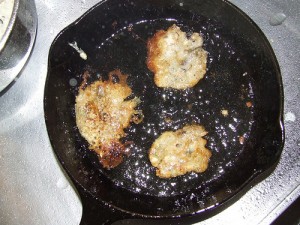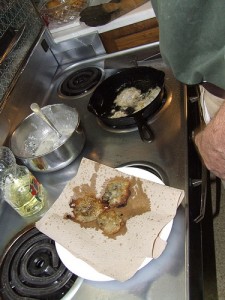Oyster fritters
1 pint shucked oysters, whole, and juices
1 cup self-rising flour
Salt to taste
½ tsp. black pepper
½ cup vegetable oil
In a mixing bowl, combine oysters and juices, flour, salt and pepper. Mix until oysters are evenly coated. Drop by large spoonfuls into 1 inch of hot oil in a skillet. Panfry on both sides until golden brown. Serves four.
I grew up around oysters and my whole family has always loved them. Many a time, we would come home from town and find a wet burlap bag full of Newport River oysters waiting on our back porch, a gift from some cousin or neighbor who had been out on the river that morning. Sometimes we’d shuck them and eat them raw. Other times we’d roast them in a pit that we dug in the field. Yet other times we’d steam them in a big pot. But my favorite oyster dish in those days was my grandmother’s oyster fritters. She’d make them for us nearly every Sunday all winter, when we came to her house after church.
I used to love watching her make her oyster fritters. All she would do is take a few oysters, a handful of flour, a dash of pepper, and of course the oysters’ own juices and make a thin batter. Then she would pour a little batter at a time into a hot frying pan and, miraculously, it seemed at the time, she turned those few plain ingredients into one of the most wonderful meals in all God’s creation. Needless to say, sitting down to a plate of my grandmother’s oyster fritters was all the lesson that I’d ever need to convince me that humanity’s highest arts could be fashioned out of the simplest things in life
The secrets to making good oyster fritters are threefold. First, use fresh, local oysters and shuck them yourself, if at all possible, so that you can put the juices into the batter. (Be sure to clean the shells well before you open them, too. You want to take special care that sand and mud don’t get into the oyster juices. I usually wash them outdoors with a garden hose) If the oysters are really fresh and juicy, you shouldn’t need to add any tap water at all and the batter will have the unimaginably rich, full-headed aromas of the salt marsh and the sea.
Second, make the batter as thin as possible. Put as little flour into the batter as you can. Thinner, thinner, thinner should be your mantra when it comes to oyster fritters. Push the envelope—try making the batter really watery and pour a little into the frying pan and if it holds together, that’s thick enough. If it doesn’t, add a tiny bit more flour and try again. When the fritters are on the heat, you want them so thin that little air bubbles will rise up on the edges of the batter. God forbid, you don’t want your fritters to resemble pancakes or hushpuppies. You want them thin and crispy.
But remember too that there’s no one right way to do this. Everybody has their own tastes when it comes to fritters. So go slow and experiment until your fritters have a consistency that you like—making oyster fritters is an art, not a science.
Third, don’t put your batter into the frying pan until the oil is really hot. That’s a key to getting the fritters really crisp. Also, use a well-seasoned cast iron frying pan. If you’re having problems getting them crispy, you might even want to try using Crisco. You need high, even heat, which is what a cast-iron frying pan and Crisco do for you, though I used plain old canola oil tonight and my mother said that they tasted just like my grandmother’s. Trust me, it’s worth the effort. If you make them like my grandmother did, you’ll get a really good oyster fritter and that unforgettably rich, wild, raucous flavor of the sea.
** *
The recipe above comes from one of my favorite coastal cookbooks, Coastal Carolina Cookery, edited by Nancy Davis and Kathy Hart. Originally published in 1986, the cookbook features traditional recipes solicited from several dozen of the coast’s best cooks. This recipe came from Vilma Morris, a commercial fisherman’s wife in Smyrna, next to Core Sound. I don’t use nearly that much oil, by the way. I also rarely add any salt—I suppose I might if I was using steamed oysters though. Also, be sure to place the fritters on paper towels to drain off the oil before serving.
Published by the University of North Carolina Press, Coastal Carolina Cookery is still in print and available for purchase atwww.uncpress.org.
Photos by Vera Cecelski


I like that your recipe calls for a pint of oysters.Only two of us eating and a quart recipe is way to much.Look forward to following your recipe.
Like this recipe. I grew up in Eastern NC, near the Pamlico Sound. Did not appreciate the availibility of seafood until I move away where I can’t get it. I recently had shipped to me, some fresh oysters and crabmeat. I just miss home!!